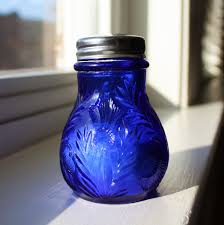How to Collect Cobalt Glass on a Budget (Beginner’s Guide)

Cobalt glass is one of the most eye-catching types of vintage glassware, known for its deep blue hue. Collectors love it because it’s as affordable as it is striking, and even beginners can start a cobalt glass collection without spending much. In this guide, we’ll cover where to buy cobalt glass, how to spot authentic pieces, and tips for finding cheap cobalt glass at thrift stores, estate sales, and online.
Here’s your guide to finding collectible cobalt glass, snagging cobalt glass bargains, and getting your feet wet as a beginner glass collector.
Where to Find Cheap Cobalt Glass
Thrift Stores: Where Surprises Hide
Don’t underestimate all the hidden cobalt glass hidden away inside your local thrift shop. You might think it's nothing but jumbled shelves and unwanted knick-knacks, but tucked behind a stack of old mugs could be a cobalt vase worth rescuing.
- Look closely. Cobalt has a tendency to stand out, but can also blend into other glassware... Especially if you're viewing it under fluorescent lights.
- Check odd spots. Every so often, holiday or clearance aisles can sometimes have a hidden bowl, pitcher, or candleholder tucked away.
- Bring light. Shine a flashlight or phone light through the glass—the best cobalt glows from within, with a depth that reproductions rarely capture.
Flea Markets and Estate Sales: The Hunt Gets Interesting
If you're looking for a bit more thrill when it comes to treasure hunting, this is where things can get really fun. Flea markets and estate sales are the perfect way to beat someone to the perfect find and feel like you're walking through time. Just remember, there are always a few tricks and tips to consider.
- Show up early if you want first pick.
- Show up late if you’re in the mood for bargains—sellers often slash prices near closing.
- Chat with vendors. Most sellers love talking about where their pieces came from, and talking can sometimes lead to discounts or tips on what’s coming up next.
And remember: a kind smile or genuine interest can come in handy from time to time and help shave a few dollars off the price.
Searching Online
Scrolling through eBay or Etsy can feel overwhelming, but it’s also an easy way to compare styles, colors, and prices. To keep from buying a reproduction:
- Zoom in on photos. Keep an eye out for unusual shades of blue, talking about things like overly bright pieces or uneven shades of blue.
- Read descriptions. Phrases like “replica” or “modern” tell you exactly what you’re getting.
- Compare prices. Prices are typically competitive when it comes to vintage and antique glassware. If something seems too good to be true... It's definitely worth a few questions.
Don’t forget local listings either—Facebook Marketplace or neighborhood sales often turn up surprising finds.
How to Tell Real from Fake
Nothing stings like realizing your “antique” is a modern knockoff. To avoid falling for a fake, try to remember a few key things:
- Weight: Older cobalt glass will typically feel heavier when held.
- Seams: Vintage pieces are known to be smoother than reproductions, which are more likely to have sharp mold lines.
- Bubbles: Flawless pieces are typically newer, factory-made pieces. Tiny air bubbles are a more normal occurrence in older glass.
When in doubt, cross-check with collector forums or reference guides. A few minutes of research can save you a lot of regret.
The Joy of the Hunt
Collecting cobalt glass isn’t only about filling a shelf; it’s about the stories behind each piece. The thrill of spotting a vase for a few dollars at a flea market, the memory of an estate sale where you walked away with a bargain, even the late-night online auction win—they all become part of the collection itself.
Quick Recap
- Don’t skip thrift stores and miss out on any treasures hidden in plain sight.
- Estate sales and flea markets reward both early birds and late bargain hunters.
- Read online listings carefully, making sure to not fall for any reproductions.
- Learn the feel and look of authentic glass.
Start small, stay curious, and enjoy the process. Soon enough, your shelves will shine with the same deep blue that first caught your eye. You might even keep an eye out for the elusive carnival glass while you're at it...
FAQ: Cobalt Glass
Q: What is cobalt glass?
A: Cobalt glass is colored with cobalt oxide, giving it that deep, vibrant blue hue. It’s been used for centuries in bottles, tableware, and collectibles due to its striking appearance and durability.
Q: Is cobalt glass valuable?
A: Cobalt glass's value depends on things like age, rarity, and condition. Antique cobalt glass pieces, like apothecary bottles or Depression glass, are often sought after by collectors, while modern reproductions are typically less valuable.
Q: How can I tell if my cobalt glass is vintage or reproduction?
A: Check for signs of age, such as pontil marks, bubbles, and wear on the base. Authentic vintage cobalt glass usually has subtle variations in color, while newer pieces tend to look more uniform.
Q: How should I clean cobalt glass?
A: Wash cobalt glass gently with warm, soapy water. Avoid abrasive cleaners or dishwashers, which can dull the surface over time. For stubborn stains, soak with vinegar or baking soda before rinsing.



